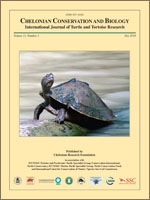Age estimation is important for management of turtle populations, but techniques such as growth ring counts or skeletochronology may be unreliable or impossible to perform. An alternative is to estimate age from growth models using Bayesian inference. However, individual variation in growth parameters needs to be incorporated into these models for them to generate realistic prediction intervals. For long-lived ectotherms such as chelonians, it is also important that models allow for changes in growth at sexual maturity, and that the growth models are combined with prior distributions reflecting realistic age structures. We describe how a hierarchical biphasic growth model fitted to a long-term data set of carapace length measurements for North American snapping turtles was combined with prior age distributions generated from survival estimates for the same population. The model was used to generate individual posterior age distributions for turtles captured on 2 or more occasions, and also for hypothetical turtles of any length that were measured only once. Posterior age distributions for hypothetical turtles were uncertain at any size due to individual variation in growth parameters, supporting the belief of many herpetologists that size is weakly related to age. Age estimates for adult turtles were also sensitive to the prior used. Using the most realistic prior, the 95% prediction intervals for large hypothetical turtles (38-cm male or 31-cm female) ranged from about 25 to 170 yrs with a median of about 70 yrs. Posterior age distributions for turtles first measured as juveniles (< 24 cm) were insensitive to the prior, and estimation precision was improved by individual growth information obtained from recaptures. For example, the 95% prediction interval for a hypothetical 10-cm turtle ranged from 2 to 14 yrs using the most realistic prior, whereas the ages of small (< 24 cm) turtles that were recaptured at least once could usually be estimated to within 1–3 yrs. Similar models could be applied to any data set where measurements and survival data are collected from a large sample of marked individuals, and could potentially be extended to incorporate data on other age indicators. This methodology allows us to produce age estimates that can be applied to management and advocacy of turtle populations while accounting for the inherent uncertainty involved.
How to translate text using browser tools
1 July 2014
Estimating Ages of Turtles from Growth Data
Doug P. Armstrong,
Ronald J. Brooks
ACCESS THE FULL ARTICLE

Chelonian Conservation and Biology
Vol. 13 • No. 1
July 2014
Vol. 13 • No. 1
July 2014
age estimation
Bayesian hierarchical modeling
biphasic growth
Chelonia
Chelydra serpentina
prior distribution
Reptilia




